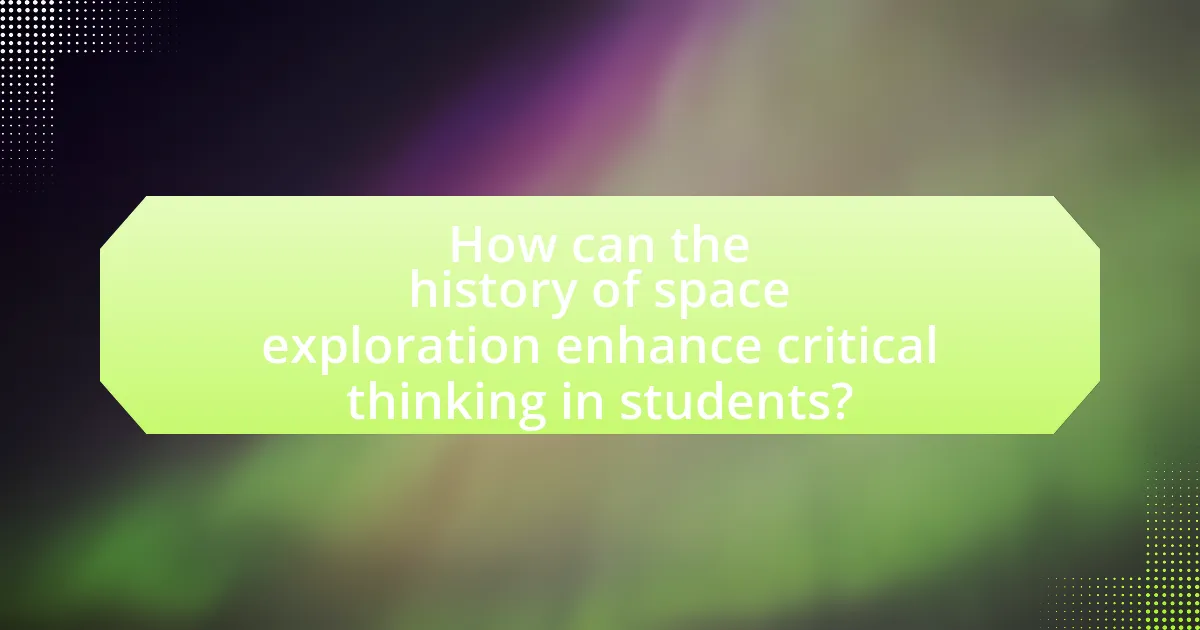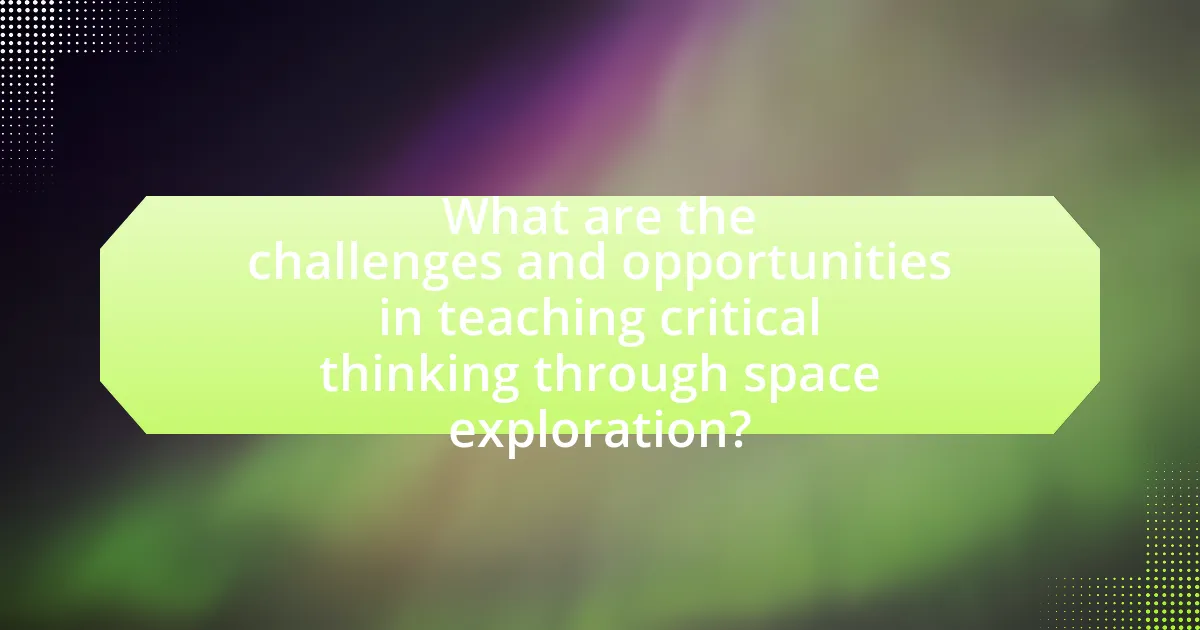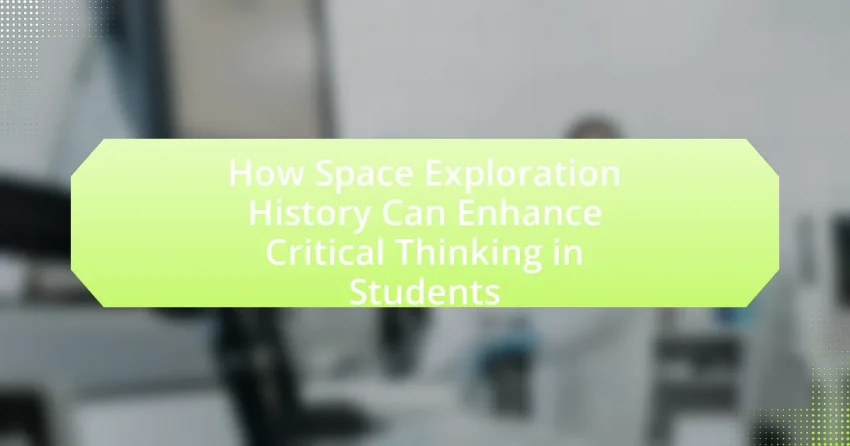The article examines how the history of space exploration can enhance critical thinking skills in students. It highlights key milestones such as the Apollo 11 mission and the Mars Rover missions, illustrating how these events serve as real-world examples of problem-solving, innovation, and interdisciplinary collaboration. The discussion includes the influence of the Space Race on educational approaches, the importance of critical thinking in education, and effective teaching strategies that incorporate space exploration themes. Additionally, it addresses challenges educators face in integrating space history into lessons and offers practical tips for fostering critical thinking through inquiry-based learning and project-based activities.

How can the history of space exploration enhance critical thinking in students?
The history of space exploration enhances critical thinking in students by providing real-world examples of problem-solving, innovation, and interdisciplinary collaboration. For instance, the Apollo 13 mission exemplifies how astronauts and engineers had to think critically under pressure to devise a solution to a life-threatening situation, leading to the development of creative engineering solutions. Additionally, studying the challenges faced during the Mars Rover missions illustrates the importance of scientific inquiry and adaptability, as teams must analyze data and adjust their strategies based on unexpected results. These historical events encourage students to engage in analytical thinking, evaluate multiple perspectives, and apply theoretical knowledge to practical scenarios, thereby fostering a deeper understanding of scientific principles and critical reasoning skills.
What are the key historical milestones in space exploration?
The key historical milestones in space exploration include the launch of Sputnik 1 in 1957, which marked the first artificial satellite in orbit, and the Apollo 11 mission in 1969, during which humans first landed on the Moon. These events are significant as they represent major advancements in technology and human capability. Sputnik 1’s launch initiated the space race, leading to rapid developments in space technology, while Apollo 11 demonstrated the feasibility of human space travel and exploration beyond Earth. Other notable milestones include the launch of the Space Shuttle in 1981, which enabled reusable spacecraft, and the Mars Rover missions, which have expanded our understanding of the Martian environment. Each of these milestones has contributed to the evolution of space exploration and has had profound implications for science and technology.
How did the Space Race influence educational approaches?
The Space Race significantly influenced educational approaches by prioritizing science, technology, engineering, and mathematics (STEM) education. This shift was driven by the need for a skilled workforce capable of supporting advancements in aerospace and technology, as evidenced by the establishment of programs like the National Defense Education Act of 1958, which aimed to enhance educational resources in these fields. Consequently, schools began to emphasize hands-on learning, critical thinking, and problem-solving skills, reflecting the urgency of competing in space exploration. This focus on STEM education has continued to shape curricula and teaching methodologies, fostering a generation of students equipped to tackle complex scientific challenges.
What lessons can be learned from the Apollo missions?
The Apollo missions teach critical lessons in problem-solving, teamwork, and innovation. These missions required extensive collaboration among scientists, engineers, and astronauts, demonstrating the importance of interdisciplinary teamwork in overcoming complex challenges. For instance, the successful resolution of the Apollo 13 crisis showcased how quick thinking and effective communication can lead to innovative solutions under pressure. Additionally, the missions emphasized the value of meticulous planning and risk assessment, as seen in the rigorous testing and simulations conducted prior to each launch. These experiences highlight the necessity of critical thinking skills in navigating uncertainties and making informed decisions, which are essential competencies for students in any field.
Why is critical thinking important in education?
Critical thinking is important in education because it enables students to analyze information, evaluate evidence, and make informed decisions. This skill is essential for navigating complex problems and fostering independent thought. Research indicates that students who engage in critical thinking are better equipped to understand and apply knowledge across various subjects, including science and history. For instance, a study published in the Journal of Educational Psychology found that critical thinking skills significantly improve academic performance and problem-solving abilities. Thus, integrating critical thinking into education enhances students’ overall learning outcomes and prepares them for real-world challenges.
How does critical thinking relate to problem-solving skills?
Critical thinking is essential for effective problem-solving skills as it enables individuals to analyze situations, evaluate evidence, and make informed decisions. When faced with a problem, critical thinking allows a person to break down complex issues into manageable parts, assess various solutions, and anticipate potential outcomes. Research indicates that students who engage in critical thinking exercises, such as analyzing historical space exploration events, develop stronger problem-solving abilities. For instance, a study published in the Journal of Educational Psychology found that students who practiced critical thinking in science contexts improved their problem-solving skills by 30% compared to those who did not. This demonstrates that critical thinking directly enhances the capacity to solve problems effectively.
What role does curiosity play in developing critical thinking?
Curiosity is essential for developing critical thinking as it drives individuals to seek out new information, question assumptions, and explore different perspectives. When students are curious, they engage more deeply with content, leading to enhanced analytical skills and the ability to evaluate evidence critically. Research indicates that curiosity fosters a growth mindset, which is linked to improved problem-solving abilities and creativity. For instance, a study published in the journal “Personality and Individual Differences” found that individuals with higher levels of curiosity tend to demonstrate better critical thinking skills, as they are more likely to challenge their own beliefs and consider alternative viewpoints. This interplay between curiosity and critical thinking is particularly relevant in the context of space exploration history, where students can explore complex scientific concepts and ethical dilemmas, further enhancing their critical thinking capabilities.

How does space exploration history provide real-world examples for critical thinking?
Space exploration history provides real-world examples for critical thinking by showcasing complex problem-solving scenarios that require analysis, evaluation, and synthesis of information. For instance, the Apollo 13 mission in 1970 exemplifies critical thinking as astronauts and mission control had to devise innovative solutions to life-threatening challenges after an oxygen tank explosion. The team utilized limited resources and collaborated effectively, demonstrating how critical thinking can lead to successful outcomes in high-stakes situations. Additionally, the Mars Rover missions illustrate the necessity of hypothesis testing and iterative design, as engineers and scientists continuously adapt their strategies based on real-time data and unexpected challenges. These historical events serve as concrete case studies that highlight the importance of critical thinking in overcoming obstacles and achieving goals in space exploration.
What case studies from space exploration can be used in the classroom?
Case studies from space exploration that can be used in the classroom include the Apollo 11 mission, the Mars Rover missions, and the Hubble Space Telescope’s discoveries. The Apollo 11 mission serves as a historical example of human ingenuity and teamwork, illustrating problem-solving under pressure when Neil Armstrong and Buzz Aldrin landed on the Moon in 1969. The Mars Rover missions, particularly Curiosity and Perseverance, provide real-time data collection and analysis opportunities, allowing students to engage with current scientific research and exploration techniques. The Hubble Space Telescope has revolutionized our understanding of the universe, offering students insights into astronomical phenomena and the scientific method through its extensive catalog of images and data. These case studies not only enhance critical thinking but also connect students with real-world applications of science and technology.
How can the Challenger disaster be analyzed for critical thinking lessons?
The Challenger disaster can be analyzed for critical thinking lessons by examining the decision-making processes and communication failures that led to the tragedy. The disaster, which occurred on January 28, 1986, resulted from the failure of O-rings in cold weather, despite engineers at Morton Thiokol expressing concerns about the launch conditions. This situation highlights the importance of evaluating evidence, considering dissenting opinions, and understanding the impact of organizational culture on decision-making. The Rogers Commission Report revealed that NASA’s management prioritized schedule over safety, demonstrating how critical thinking can be compromised by external pressures. By studying these factors, students can learn to recognize the significance of thorough analysis, effective communication, and ethical responsibility in decision-making processes.
What insights can be drawn from the Mars Rover missions?
The Mars Rover missions provide critical insights into the potential for past life on Mars, the planet’s geology, and the viability of future human exploration. These missions, including Spirit, Opportunity, Curiosity, and Perseverance, have discovered evidence of ancient water, analyzed soil and rock samples, and identified organic molecules, suggesting that Mars once had conditions suitable for life. For instance, Curiosity found clay minerals and signs of ancient riverbeds, indicating a wetter climate in Mars’ history. Additionally, the Perseverance rover is actively collecting samples to be returned to Earth, which will further enhance our understanding of Martian history and its habitability. These findings not only advance scientific knowledge but also serve as a foundation for educational initiatives, fostering critical thinking in students as they analyze data and draw conclusions about planetary science and exploration.
How can educators incorporate space exploration into their curriculum?
Educators can incorporate space exploration into their curriculum by integrating hands-on projects, interdisciplinary lessons, and current events related to space missions. For instance, projects like building model rockets or simulating Mars rover missions engage students in practical applications of science and engineering principles. Interdisciplinary lessons can connect space exploration to subjects such as mathematics, where students calculate distances in space, or history, where they study the timeline of significant space missions like the Apollo program, which landed humans on the Moon in 1969. Additionally, discussing current events, such as NASA’s Artemis program aimed at returning humans to the Moon, can foster critical thinking by encouraging students to analyze the implications of space exploration on technology and society.
What teaching strategies can enhance critical thinking through space topics?
Teaching strategies that can enhance critical thinking through space topics include inquiry-based learning, project-based learning, and the Socratic method. Inquiry-based learning encourages students to ask questions and explore space phenomena, fostering a deeper understanding of scientific concepts. Project-based learning allows students to engage in hands-on projects related to space exploration, promoting problem-solving and critical analysis skills. The Socratic method, through guided discussions about ethical implications and scientific discoveries in space, stimulates critical thinking by challenging students to articulate their reasoning and consider multiple perspectives. These strategies are supported by educational research indicating that active engagement in learning processes significantly improves critical thinking abilities among students.
How can project-based learning be applied to space exploration themes?
Project-based learning can be applied to space exploration themes by engaging students in hands-on projects that simulate real-world space missions. This approach allows students to explore concepts such as rocket design, planetary geology, and the challenges of living in space through collaborative problem-solving and critical thinking. For instance, a project could involve designing a Mars rover, where students must research the Martian environment, understand engineering principles, and apply scientific methods to create a functional prototype. Research indicates that project-based learning enhances student engagement and retention of knowledge, as evidenced by studies showing improved performance in STEM subjects when students participate in inquiry-based projects related to space exploration.

What are the challenges and opportunities in teaching critical thinking through space exploration?
Teaching critical thinking through space exploration presents both challenges and opportunities. One significant challenge is the complexity of scientific concepts involved in space exploration, which can overwhelm students and hinder their ability to engage critically with the material. For instance, understanding astrophysics or orbital mechanics requires a solid foundation in mathematics and science, which not all students possess. Conversely, an opportunity lies in the interdisciplinary nature of space exploration, allowing educators to integrate subjects like history, technology, and ethics, thereby fostering a more holistic critical thinking approach. Research indicates that project-based learning, such as designing a mission to Mars, can enhance critical thinking skills by encouraging students to analyze problems, evaluate solutions, and collaborate effectively. This method not only makes learning more engaging but also equips students with essential skills for real-world problem-solving.
What obstacles do educators face when integrating space history into lessons?
Educators face several obstacles when integrating space history into lessons, including a lack of resources, insufficient training, and curriculum constraints. Limited access to up-to-date materials and technology can hinder the effective teaching of space history, as many educators may not have the latest information or tools to engage students. Additionally, many teachers report feeling unprepared to teach complex scientific concepts related to space exploration due to inadequate professional development opportunities. Furthermore, existing curriculum frameworks often prioritize standardized testing and core subjects, leaving little room for the inclusion of interdisciplinary topics like space history. These challenges collectively impede the ability of educators to effectively incorporate space exploration history into their teaching, which is essential for fostering critical thinking skills in students.
How can limited resources be overcome in teaching space exploration?
Limited resources in teaching space exploration can be overcome by leveraging online platforms and community partnerships. Online resources, such as virtual simulations and free educational materials from organizations like NASA, provide accessible content that enhances learning without significant financial investment. Additionally, partnerships with local universities and science centers can offer access to expert knowledge and hands-on experiences, enriching the educational process. For instance, NASA’s educational outreach programs often provide free resources and workshops that educators can utilize to enhance their curriculum. These strategies effectively maximize available resources while fostering critical thinking skills in students through engaging and interactive learning experiences.
What support systems can be established for teachers?
Support systems that can be established for teachers include professional development programs, mentorship initiatives, and collaborative teaching networks. Professional development programs provide ongoing training in innovative teaching methods and subject matter expertise, which is essential for enhancing educators’ skills. Mentorship initiatives pair experienced teachers with novices, fostering guidance and support that can improve teaching practices. Collaborative teaching networks encourage teachers to share resources, strategies, and experiences, promoting a community of practice that can lead to improved student outcomes. Research indicates that such support systems significantly contribute to teacher retention and effectiveness, ultimately benefiting student learning experiences.
What best practices can be adopted for effective teaching?
Effective teaching can be achieved by incorporating active learning strategies, such as collaborative projects and problem-based learning. These methods engage students in the learning process, fostering critical thinking and deeper understanding. Research indicates that active learning can improve student performance by up to 50% compared to traditional lecture-based approaches, as shown in a meta-analysis by Freeman et al. (2014) published in the Proceedings of the National Academy of Sciences. Additionally, integrating real-world applications, such as space exploration history, can enhance relevance and stimulate student interest, further promoting critical thinking skills.
How can collaboration with space agencies enhance learning experiences?
Collaboration with space agencies can enhance learning experiences by providing access to cutting-edge research, real-world applications, and expert knowledge in science and technology. For instance, partnerships with organizations like NASA allow educational institutions to incorporate authentic space missions into their curricula, fostering engagement and critical thinking. Programs such as NASA’s Educational Resources offer students hands-on activities that align with STEM standards, promoting problem-solving skills and innovation. Research indicates that students involved in such collaborative projects demonstrate improved analytical abilities and a deeper understanding of complex scientific concepts, as evidenced by studies showing increased interest in STEM fields among participants.
What are some successful examples of critical thinking programs in education?
Successful examples of critical thinking programs in education include the “Philosophy for Children” program, which encourages students to engage in philosophical discussions, enhancing their reasoning skills. Another example is the “Project Zero” initiative from Harvard University, which focuses on developing students’ critical thinking through arts-based learning. Additionally, the “Debate Program” in various schools fosters critical analysis and argumentation skills among students. These programs have been shown to improve students’ ability to think critically, as evidenced by research indicating that students involved in such initiatives demonstrate higher levels of analytical thinking and problem-solving abilities.
What practical tips can educators use to foster critical thinking through space exploration?
Educators can foster critical thinking through space exploration by incorporating inquiry-based learning, encouraging problem-solving activities, and utilizing real-world data from space missions. Inquiry-based learning allows students to ask questions and explore topics related to space, promoting deeper understanding and engagement. Problem-solving activities, such as designing a mission to Mars or analyzing the challenges of living in space, require students to apply critical thinking skills to develop solutions. Utilizing real-world data, such as NASA’s Mars rover findings or satellite imagery, provides concrete examples that enhance analytical skills and encourage students to draw conclusions based on evidence. These methods have been shown to improve critical thinking abilities in students, as they actively engage with the material and apply their knowledge in practical scenarios.
